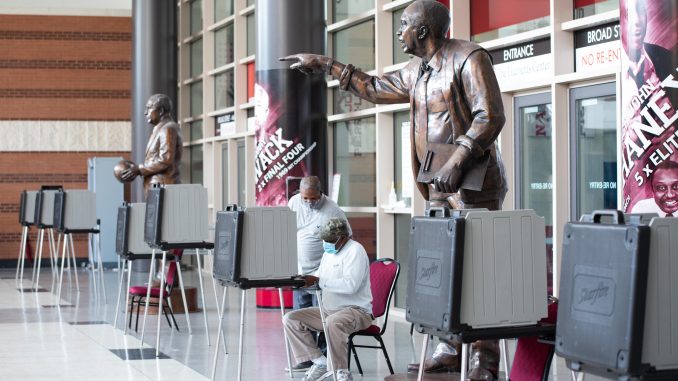
Brendan McAvoy stood in line outside Temple University’s Liacouras Center, which has been transformed into one of several satellite election offices in Philadelphia, on Monday morning, eager to request and return a mail-in ballot for this year’s general election.
McAvoy, a senior history major who also voted by absentee ballot in the 2016 primary election, likes mail-in voting because it gives him the chance to consider the candidates and issues without the pressure of voting quickly in person.
“You’re getting to do research about it, you can sit down and read about the candidates running, read about what the [ballot questions] would mean for the city,” he said. “I would keep doing mail-in ballots in the future, personally.”
McAvoy is one of nearly 14,200 residents in the 181st Legislative District, which encompasses Temple’s Main Campus, out of more than 388,000 residents in Philadelphia to have requested mail-in ballots for this year’s general election, according to data from the Pennsylvania Department of State.
The data shows a sharp increase from the roughly absentee 20,000 ballots issued to Philadelphians in 2016, according to data from the U.S. Election Assistance Commission.
In Pennsylvania, the number of mail-in ballots requested has increased from fewer than 323,000 in 2016 to nearly 2.8 million this election, according to the USEAC and Department of State data.
The spike in mail-in voting is in part due to concerns regarding in-person voting amid the COVID-19 pandemic and the signing of Act 77, which allows Pennsylvania voters to vote by mail without a formal excuse, in October 2019.
“The change in modes of voting this year is unlike anything we’ve ever seen in the state, ever,” said Patrick Christmas, policy director at Committee of Seventy, a nonpartisan civic engagement organization in Philadelphia. “It’s an unprecedented change both in election law, in election systems, and on the voter side, the procedures they’ve got to follow.”
Nationally, voters have requested or been sent 83.5 million absentee ballots for the general election following the loosening of absentee voting eligibility rules in many states, the New York Times reported.
The final day to request a mail-in ballot in Pennsylvania is Oct. 27 at 5 p.m., according to the Department of State. Mail-in ballots must be postmarked no later than Nov. 3 at 8 p.m. and received by the county election office on Nov. 6 by 5 p.m. to count.
A potential concern for voters is the U.S. Postal Service’s ability to process mail-in ballots in time for them to be counted, which the agency warned in August it would not be able to guarantee, the Washington Post reported.
The anticipated volume of election mail this year will be less than what the agency handles during the holiday season, and the USPS is “actively working” to handle the anticipated increase in mail in the coming weeks, wrote Ray Daiutolo, a spokesperson for the USPS’s South Jersey and Philadelphia districts, in an email to The Temple News.
“The Postal Service has allocated additional resources, including, but not limited to, expanded processing procedures, extra transportation, extra delivery and collection trips, and overtime, to ensure that election mail reaches its intended destination in a timely manner,” Daiutolo wrote.
As of Oct. 19, nearly 50 percent of all requested mail-in ballots have been returned in Philadelphia, with 42.5 percent of those in the 181st Legislative District returned so far.
Easter Fullwood, who lives on Rowan Street near Germantown Avenue, went to return a mail-in ballot at the Liacouras Center on Monday so she wouldn’t have to worry about it later, she said.
“I’m gonna get it done and get it over with,” said Fullwood, who works in customer service.
Mail-in ballot requests in Philadelphia lean slightly Democratic, with nearly 84 percent of all mail-in ballots being requested by Democrats in a city where they comprise 76 percent of all registered voters, according to the Department of State.
In the 181st district, mail-in ballots lean Democratic relative to the rest of the city, with 86 percent of requests coming from Democratic voters.
Christmas attributes the Democratic lean of mail-in ballots, which reflects a national trend, in part to United States President Donald Trump’s criticism of mail-in voting.
Trump has claimed without evidence that expansion of mail-in voting would cause widespread fraud, NPR reported.
“It’s one of our biggest concerns this fall, actually, that there’s going to be some significant amount of distrust in the election results because of the mis- and the disinformation that’s being disseminated by the president,” Christmas said.
Election Day is Nov. 3. Click here to read more about how to vote and which candidates are on the ballot.
Amelia Winger contributed reporting.


Be the first to comment